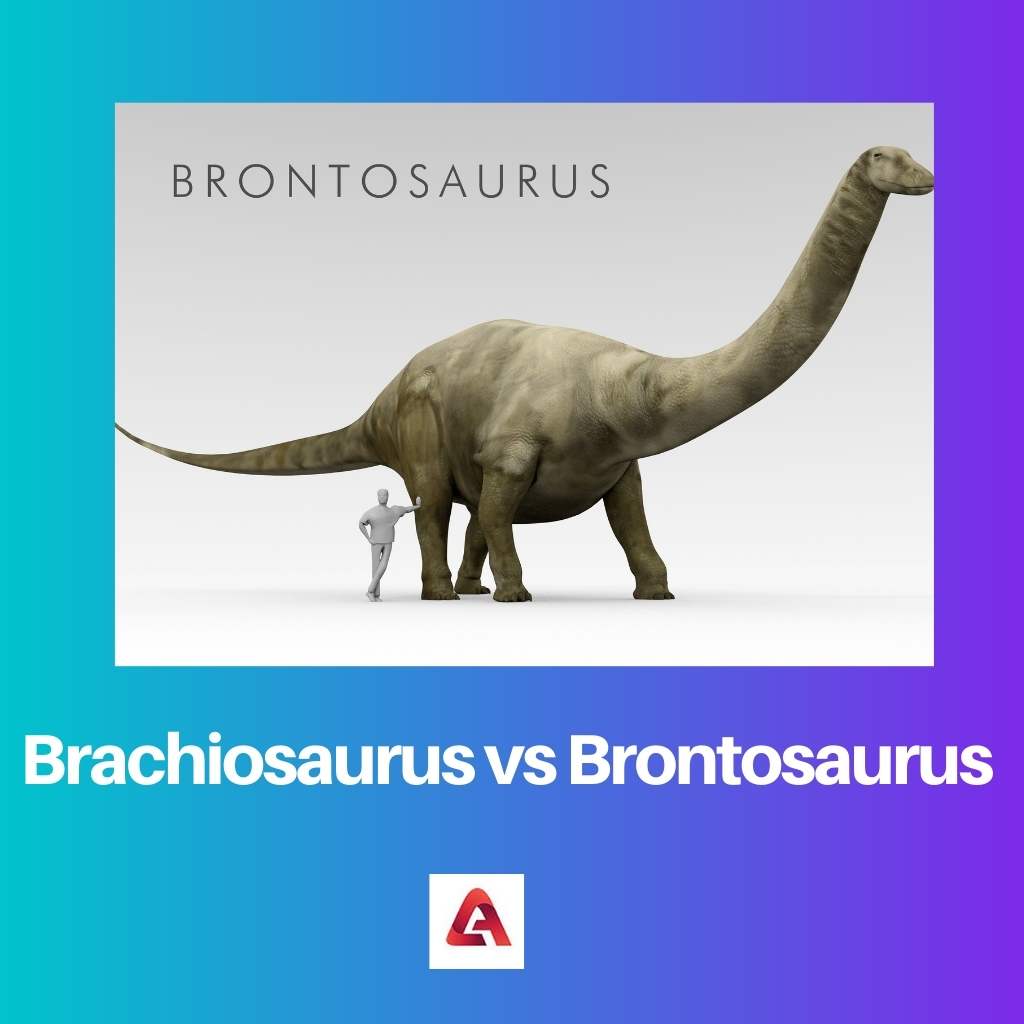Dinosaurs are a diverse group of clade Dinosauria reptiles. During the Triassic period, the dinosaur first appeared, which is between 243 and 233.23 million years ago.
After the Triassic or Jurassic extinction event, they became the dominant terrestrial vertebrates.
Although the exact timing and origin them is still the subject of active research, when it comes to giant sauropods genera, brachiosaurus and Brontosaurus are two of them.
In this article, the main focus is on differentiating the Brachiosaurus and the Brontosaurus.
Key Takeaways
- Brachiosaurus features longer front legs and a more elevated neck, while Brontosaurus has a more horizontal posture with even leg lengths.
- Brachiosaurus’ nostrils sit atop its skull, whereas Brontosaurus’ nostrils reside at the front of the snout.
- Brachiosaurus lived during the Late Jurassic period, while Brontosaurus thrived in the Late Jurassic to Early Cretaceous period.
Brachiosaurus vs Brontosaurus
Brachiosaurus had longer forelimbs than hindlimbs, which gave it a steeply inclined back, and was estimated to be around 85 feet in length. Brontosaurus had a more level back and was estimated to be around 72 feet in length, and its forelimbs and hindlimbs were more similar in length.

155.7-150.8 million years ago, brachiosaurus is a gigantic and herbivorous dinosaur that used to live in Tanzania, Africa, and North America during the mid to late Jurassic period.
The chief characteristic feature is the long neck as well as short hind legs, and that’s why known as the arm lizard.
150 million years ago, a herbivorous dinosaur, namely, brontosaurus, used to live in the northern hemisphere’s western part during the late Jurassic period. Its remains were found in Wyoming, Mexico, and Utah.
It had a long neck which was counterbalanced by a long tail.
Comparison Table
| Parameters of Comparison | Brachiosaurus | Brontosaurus |
|---|---|---|
| Other names | Arm lizard | Thunder lizard |
| Weight | Between 28.3 to 58 metric tons | Up to 15 tons |
| Limbs | Compared to back legs had front legs were much longer. | Compared to back legs had front legs were slightly shorter. |
| Browsing | Grazed high canopies of trees | Ate ground vegetation |
| Length | Between 18 and 21 meters long | Between 22 and 26 meters long |
What is Brachiosaurus?
Brachiosaurus was first described in 1903 by American palaeontologists, namely Elmer S. Riggs, from fossils found in western Colorado’s Colorado River Valley, United States.
The generic name of the dinosaur is Brachiosaurus altithorax is from Greek and means arm lizard in its proportionately long arms reference.
The deep chest is the meaning of its specific name. Brachiosaurus is estimated to have a weight range from 28.3 to 58 metric tons or 31.2 and 64 short tons. It is estimated to have been ft between 59 and 69 or 18 and 21 meters long.
Brachiosaurus had a disproportionately small skull, large overall size, and long neck, all of which are particular for sauropods.
Atypically, it had longer forelimbs compared to hind limbs and resulted in a trunk that is steeply inclined and a tail that is proportionally shorter tail.
Though the torso or trunk vertebral column is incompletely known, the back of the brachiosaurus most likely consists of twelve dorsal vertebrae.
This can be inferred from the complete dorsal vertebral column, which is preserved in an unnamed brachiosaurid specimen.

What is Brontosaurus?
Brontosaurus was a long-necked, quadrupedal, large animal with a whiplike, long tail. The largest species, brontosaurus excelsus measured up to 72 ft or 22m long from tail to head and weighed up to 15 t or 17 short tons.
The brontosaurus’s skull has not been found but was similar to the skull of the Apatosaurus.
Like other sauropods, the neck’s vertebrae were deeply bifurcated that is they carried spines that were paired and resulted in a deep and wide neck.
The tail-end spine consisted of 15 cervicals, five sacrals, 82 caudals, and about ten dorsals.
The cervical vertebrae were stouter compared to diplodocids. The dorsal ribs are not tightly attached or fused to their vertebrae, instead, they are articulated loosely. The large neck was filled with weight-saving air sacs extensive system.
As in other diplodocids, the tail’s portion possessed a whiplike structure.
On each forelimb, the brontosaurus had a single large claw, and each foot possessed claws on the first three toes. The bone of a single front claw is slightly curved, and on the front end, it is squarely shortened.
The hip bones included fused pubes and robust ilia and ischia.

Main Differences Between Brachiosaurus and Brontosaurus
- In 1903, the brachiosaurus was first described by Elmer S. Riggs was an American palaeontologist. Meanwhile, in 1879, brontosaurus was first described by Othniel Charles Marsh, who was an American paleontologist at Yale University.
- When it comes to neck posture, the brachiosaurus had a naturally upright neck poster. On the other hand, the brontosaurus is known to have a lower neck posture.
- Brachiosaurus had a long tail and neck. To the ground, its neck held at a degree angle of 70 or 80, but to the ground, its tails held parallel. Conversely, the brontosaurus had a thick neck and long tail, both of which were held to the ground parallelly.
- In terms of presence, around the world, brachiosaurus were widely distributed with a population high in number. In contrast, in the hemisphere of the north, brontosaurus used to live in the western part.
- The period of the brachiosaurus is from the mid to late Jurrasic periods, or simply 155.7 million to 150.8 million years ago. On the flip side, the late Jurassic and early Cretaceous periods of or simply 163.5 million to 100.5 million years ago.




